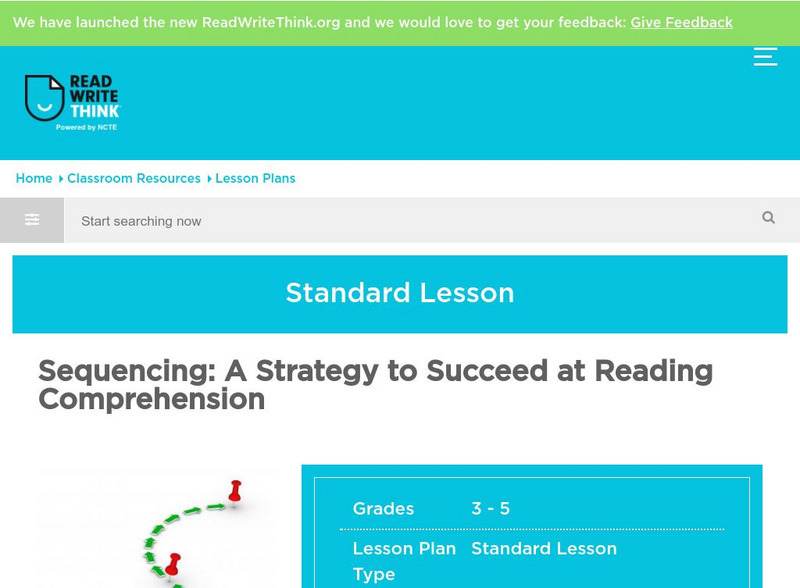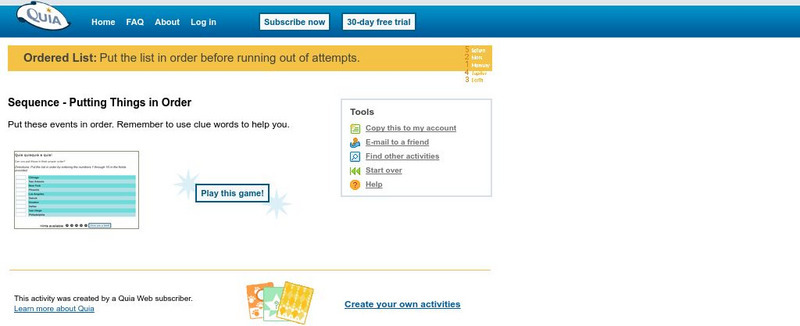California Academy of Science
Guess That Spice
From medical treatments to cooking, people have been using herbs and spices for thousands of years. Perform a blind smell test of household herbs and spices to engage students in learning about ancient spice trading. Research the history...
Curated OER
Presenting Information
How do you make a pizza? Scholars examine a recipe for one of their favorite dishes. After reading the eight steps, they must re-write the steps in order. Although this offers great printing practice, younger writers may find the narrow...
Scholastic
Thanksgiving Lessons Grades PreK-2
A quintessential resource for teaching an elementary unit on the first Thanksgiving addresses a variety of skills, including informational reading, critical thinking, comparing and contrasting facts, technology tools, and historical...
Curated OER
The Fable of Franny And Her Fabulous Fainting Goat
Mix the art of reading comprehension with the skill of telling time. Children in grades two and three will discuss the importance of goats throughout history based on the provided background information. They'll create cute goat clocks...
Curated OER
Plant Parts We Eat
I bet the kids in your class will love to eat their vegetables after an engaging lesson plan about edible plants. They read information about vegetables and edible plants, sort vocabulary words, identify plant parts, measure and graph...
Curated OER
Baby Peanut Plants
Science is a subject ripe with opportunities to read informational text. Kids read to learn about peanuts! They read an informational passage, fill out two comprehension worksheets, and then conduct a lab experiment on a peanut. The...
Curated OER
Agriculture in Motion
Youngsters learn about simple machines that could be used on a farm. They learn about agricluture, listen to a farmer speak, compare and contrast different farm machines, and then design their own. Note that although the publisher...
Curated OER
Bread in a Bag
This lesson focuses on making bread, but also spends some time on the origins of wheat. In order to make the bread, each class member receives a kit full of the materials they will need. Included here is a detailed list of instructions...
University of South Florida
Fcat Express: Plot & Conflict Resolution
Strategies to help students understand the elements of a story provided by a standardized test preparation site intended for fourth grade. Includes strategies such as DLTA/DRTA, Plot Diagrams, Story Clock, Story Mapping, Summary...
University of South Florida
Fcat Express: Story Mapping
Site provides extensive assistance in preparing 4th grade students for Florida Comprehensive Assessment Test. This section focuses on story mapping, which helps students put events of a story in sequential order.
University of South Florida
Fcat Express: Chronological Order
The site provides extensive assistance in preparing 4th-grade students for Florida Comprehensive Assessment Test. This section focuses on identifying the chronological order.
University of South Florida
Fcat Express: Chronological Order
Strategies to help students recognize the order of events in a selection provided by a standardized test preparation site intended for fourth grade. Includes strategies such as plot diagrams, probable passages, story mapping, summary...
PBS
Pbs Teachers: Story Writing With Arthur
This series of 12 downloadable activities teach students some basics of story writing, using books or videos from the PBS "Arthur" series as a springboard. Activities include creating story maps, asking questions about characters and...
Reading Rockets
Reading Rockets: Reading Topics a to Z: Scientific Language in Primary Grades
Research on the importance of teaching scientific language usage, ideas for utilizing scientific language, and rubrics for assessing student use of scientific language in grade schools.
Tufts University
Tufts University: Novel Engineering: Books
This collection of classroom books shows how students can identify engineering problems in a novel. Each book is accompanied by a plot synopsis, problems students have noted, and solutions they have come up with and built in their...
Michigan State University
Michigan State University: Intervention for Reading: Group Story Mapping
This intervention, which is based on Schema Theory, emphasizes linking previous knowledge structures (schemata) with reading materials. A pre-reading technique (see "My Story Map") provides a framework that directs students' attention to...
Writing Fix
Writing Fix: Moving Through a Machine
After enjoying chapter 3 from Robert McCloskey's classic chapter book Homer Price students will work together to expand upon McCloskey's description of how the donut-making machine works. Focusing on a variety of transitions, students...
Curated OER
Mc Graw Hill: Major Events
Learn how writers use details to describe major events in a story.
PBS
Pbs Kids: Martha: True Stories
A collection of interactive story activities about topics including the environment, technology, inventions, and measuring. There are four stories about each of the topics. In addition to being able to page through the books, the books...
Polk Brothers Foundation Center for Urban Education at DePaul University
De Paul University: Center for Urban Education: I Can Analyze a Story or History [Pdf]
This graphic organizer can be used to help students analyze a story or a historical event. Students will look closely at the story's characters or people involved in the historical event. Then they will summarize the story or event, and...
Other
Laus Dnet: Grade 1 Word Lesson Plan (Stone Soup) Pdf
In this lesson plan, students use Stone Soup by Ann McGovern to generate word lists and use patterned text to assist with descriptive writing. Gives links to step sheets and samples for creating a table , a template for shared writing, a...
ReadWriteThink
Read Write Think: Sequencing a Strategy to Succeed at Reading Comprehension
Contains plans for lessons that use the story of Paul Bunyan to teach about sequencing and order of events. In addition to objectives and standards, this instructional plan contains links to sites used in the lessons as well as...
Quia
Quia: Sequence: Putting Things in Order
Using clue words, students are asked to number a list of events in order from 1-10 and then check answers. Students have up to three attempts to solve.
ReadWriteThink
Read Write Think: Exploring Before, During, After Sequencing
From Read-Write-Think, here is a three-day lesson plan in which a class collaborates to produce a book, focusing on carving a jack-o-lantern. The emphasis is on teaching the skill of sequencing events.


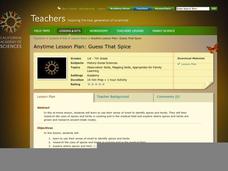

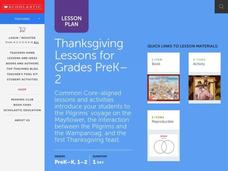








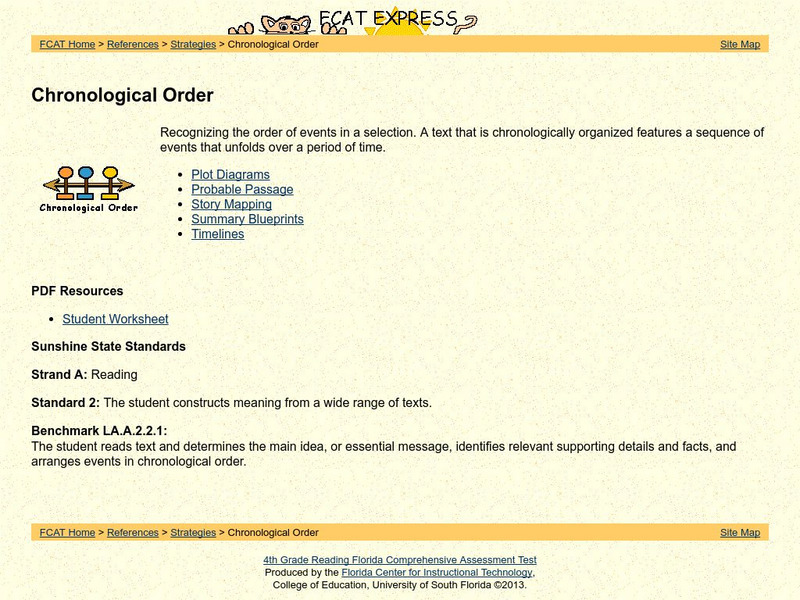




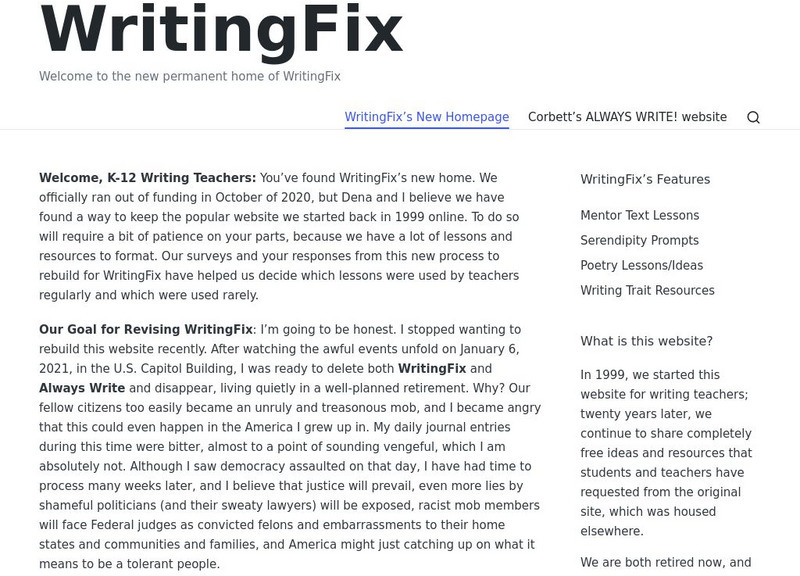


![De Paul University: Center for Urban Education: I Can Analyze a Story or History [Pdf] Graphic De Paul University: Center for Urban Education: I Can Analyze a Story or History [Pdf] Graphic](https://d15y2dacu3jp90.cloudfront.net/images/attachment_defaults/resource/large/FPO-knovation.png)

